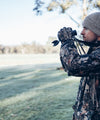Recent Post
Archive
- January 2023
- August 2022
- May 2022

Reading Binoculars Packaging 1: Understanding Magnification and objective lens
Dec 28, 2022
0 comments
If you're new to astronomy or outdoor enthusiasts, you may be wondering how to choose the right binoculars for your needs. One important factor to consider is the magnification and objective lenses. In this article, we will introduce you to the basics of binocular magnification and objective lenses and provide some tips for selecting the right binoculars for your interests and needs. We will also introduce you to GoSky's Megamiles binoculars, a popular choice for many outdoor enthusiasts.

When shopping for binoculars, you'll likely see a series of numbers on the package that represents the binoculars' magnification and objective lens size. It's important to understand these numbers in order to pick the right binoculars for you. Magnification, often represented by an "x" followed by a number, refers to how much larger an object appears through the binoculars. For example, a magnification of 10x means that the object will appear 10 times larger through the binoculars than it does with the naked eye. It's important to note that magnification alone is not the only factor to consider when selecting a binocular. High magnification is not necessarily better if the binoculars' objective lens (the lens at the front of the binoculars) is not large enough to gather enough light. The size of the objective lens, often represented by a number followed by "mm," refers to the diameter of the lens. A larger objective lens will gather more light and provide a brighter, clearer image. However, larger objective lenses also tend to be heavier and more expensive. When selecting binoculars, it's important to consider both magnification and objective lens size. Binoculars with high magnification and a large objective lens will provide a brighter, clearer image, but they may also be heavier and more expensive. On the other hand, binoculars with lower magnification and smaller objective lenses may be more portable and affordable, but the image may not be as bright and clear.

While a higher magnification may seem like a good thing, there are a few points to consider.
First, the greater the magnification, the smaller the actual field of view. This means that with a higher magnification, you will be able to see a smaller area in greater detail, but you may miss out on other objects in the surrounding area. This can be especially frustrating when trying to find a specific object in the sky, as it can be difficult to locate with a narrow field of view.
Second, the limiting magnification for handheld binoculars is generally considered to be around 12. This is because the image can become shaky when holding binoculars with a higher magnification, making it difficult to see the object. Unless you have an extra tripod to stabilize the binoculars.
Finally, it's important to note that with the same objective lens of the binoculars, the greater the magnification, the lower the brightness of the image.
Overall, it's important to consider the magnification when selecting binoculars, especially handheld ones. While a higher magnification may seem appealing, it's important to consider the trade-offs in terms of field of view, image stability, and brightness.

There are a few different magnification options to consider, each of which is suitable for different activities and needs.
Small magnifications of 6x or lower may be the best option for novice friends interested in wilderness adventures, hiking, or travel. These binoculars or monoculars will have a smaller weight and volume, making them easy to carry and convenient to use. They can also be used in a variety of settings, such as a stadium or theater, and are ideal for light and easy travel.
Medium magnifications of 6x to 10x are also common and have a variety of uses. These binoculars or monoculars are particularly suitable for activities such as bird watching, hunting, and travel. 8x and 10x are especially popular and can be used in a wide range of scenarios.
Finally, magnifications of 10x or higher are generally considered higher magnifications. These binoculars or monoculars may require a tripod to be carried along for stability, as the higher magnification can lead to a shaky image. These binoculars or monoculars are suitable for outdoor activities with friends, such as bird watching, and may be preferred by more experienced users.
It's important to note that the magnification choices outlined above are generally referred to when it comes to telescope and monoculars. If you are interested in a spotting scope or binoculars, the magnification choices may be different. This will be covered in a future article.
To help visualize the difference in magnification, the following chart shows how different magnifications can be used to see different scenes.
Overall, it's important to consider the magnification when choosing binoculars or monoculars. You can choose the right magnification by considering your intended use and personal preferences.
In addition to the magnification, it's also important to consider the caliber of binoculars. The caliber of binoculars is used to indicate the size and clarity of the field of view. It is also known as the objective lens caliber, which refers to the size of the lens at the front of the binoculars.

The caliber of binoculars refers to the size of the lens at the front of the binoculars, and it plays an important role in the size and clarity of the field of view. A larger caliber will result in a larger field of view and a brighter, clearer image. However, it's important to note that a larger caliber can also make the binoculars bulky and inconvenient to carry. Therefore, it's important to consider both the performance of the binoculars and the convenience of carrying them when choosing a caliber. If you are a novice to binoculars, it may be best to choose a caliber that is not too large, to avoid finding the binoculars too bulky and uncomfortable to carry. For these reasons, it's important to consider both the performance and convenience of binoculars when making a choice.
In future articles, we will continue to bring popular content to outdoor enthusiasts and share experiences with new friends. In the next issue, we will cover the field of view and field of view of binoculars.
← Older Post Newer Post →




